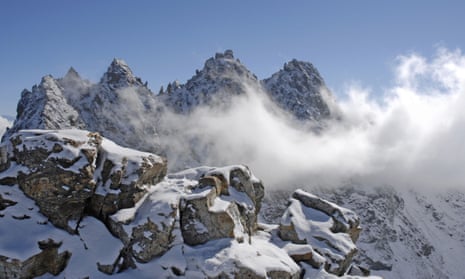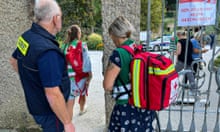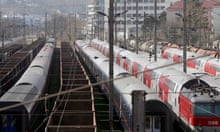Thousands of tonnes of rock have broken off the summit of a mountain popular with climbers and tumbled into a valley in Austria, in an incident blamed by geologists on melting snow and thawing permafrost.
The incident on the Fluchthorn massif, part of the Silvretta Alps in the state of Tirol close to the Swiss border, led to a huge volume of black and grey rocks cascading down the mountain, and created clouds of thick dust visible for miles around, before much of the debris was carried away by a river, authorities said.
“Hundreds of metres of the summit have simply broken off,” Christian Walter, head of mountain rescue for the Austrian region of Galtür, told local media.
Geologists told the Austrian news agency APA that the rockfall, which had been predicted for some time, had taken away part of the southern summit, including the crucifix typically found on mountain peaks in the region. They blamed melting glaciers as well as the thawing of permafrost due to the climate crisis for the collapse, which occurred on Sunday and was captured on film by mountain rescuers training in the region.
The witness video, which was published in the Tiroler Tageszeitung, showed scree and rocks hurtling towards the valley. Authorities said that no one was hurt.
Police helicopters flew above the 2 sq km area affected, looking for people who might have been caught up in the avalanche but reported finding no evidence of anyone having come to harm.
Last month the Swiss village of Brienz in Graubünden had to be evacuated after its 50 residents were warned that similar conditions on the huge, 2m cubic metres of rock formations overlooking the community were in imminent danger of collapsing.
Since the clearance of the village, a number of rocks, small and large, have broken off and fallen in the direction of the village. The Swiss tabloid Blick has erected a camera in the area to capture the drama via a livestream link, but experts say they have been unable to judge how much rock has so far fallen.
Since Sunday’s collapse of Fluchthorn, mountaineers have raised concerns about one of the most popular summits in the Allgäu Alps, the Hochvogel, which is just kilometres away in southern Germany.
But authorities have said despite the fact it has been slowly disintegrating over several years, and a massive rock avalanche was a possibility, the danger of it collapsing was not thought to be imminent.
If the mass of rock – estimated to be up to 260,000 cubic metres in size, which is showing visible cracks and fissures on its 2,592-metre high summit – were to fall, it would land in an uninhabited part of the area. At the most, inhabited areas would be affected by resulting clouds of dust, a spokesperson for the Oberallgäu district told local media. A hiking path in that location was closed more than a decade ago because of the dangers of rockfall.








